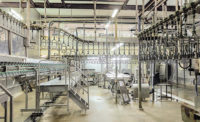Tech | Supplier's Perspective
Is cleaning, sanitizing enough to establish 'sanitary' conditions?

According to industry estimates, at least one-third of food recalls in North America may directly be related to sanitation, hygiene and material handling issues in food facilities. On an associative note, the CDC lists unsanitary equipment and surfaces as one of the top five contributing factors of foodborne illness outbreaks.
But we must consider whether cleaning and sanitizing environmental surfaces is sufficient to achieve the sanitary conditions necessary for the production of safe and wholesome food in meat facilities.
Legal implications
The expectations from the Federal Meat Inspection Act are clear: Raw meat and meat products must be slaughtered and processed under sanitary conditions or they are deemed adulterated. In this context, sanitary means conforming to practices that promote public health by assuring the freedom from disease-causing agents.
Though the principal causative agents are bacterial pathogens such as Listeria monocytogenes, Salmonella and Shiga-toxin producing Escherichia coli, undeclared allergen presence and foreign-material contaminants in products are not uncommon. U.S. Food Safety and Inspection Service (FSIS) inspectors in federally registered meat plants are normally on the lookout for these food-safety hazards along the production line, and regulatory action may range from initiating product holds to issuing a notice of suspension to non-compliant sites.
Pre- or post-kill intervention?
Where should a site establish sanitation controls, and how does it arrive at that decision? According to the Industry Guidance for control of Listeria monocytogenes in ready-to-eat (RTE) foods, there is a greater focus on enhanced sanitation protocols post-kill step (e.g. cooking) after which there is no further hazard-control intervention. This is, however, a risk-based decision, and the general hazard risk assessment formula is: Risk = Likelihood of Occurrence * Severity of Consequence(s) to Public Health
As an example, allergens cannot be adequately destroyed during the cook step. So, to mitigate the risk, allergen cross-contact incidents must be prevented throughout the processes, whether at pre-or post-kill steps.
Nooks and crannies
The risk equation seems to get into complications owing to the fact certain equipment and facility zones are difficult to access, inspect or clean. Moreover, it’s not surprising to note that more than 10 percent of FSIS food recalls relate to foreign-material contamination by metal, plastic or glass fragments. Therefore, the improved risk assessment formula may look like this: Hazard Risk Level = (Likelihood * Severity) / (Detectability * Controllability)
In a nutshell, to ameliorate the risk, assessment is not enough. We also need to detect the hazard in the most difficult places, the nooks and crannies, and be able to control them with timely, consistent and robust interventions.
Integrated sanitation approach
The key argument here is that establishing or maintaining sanitary conditions in a meat plant is no mean task and requires robust control interventions. Reworking the improved equation, we get: Control intervention index = Controllability = (Likelihood * Severity) / (Detectability * Risk level)
In summary, we cannot rely only on cleaning and sanitizing surfaces to achieve the broader sanitation goal of keeping food safe across the process chain. An emphasis on hygienic zoning, building and tools combined with personnel hygiene and preventive maintenance are other key controllability factors that need to be explored in this vital risk-based decision equation. NP
Looking for a reprint of this article?
From high-res PDFs to custom plaques, order your copy today!








